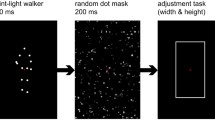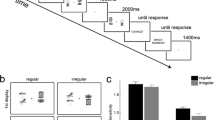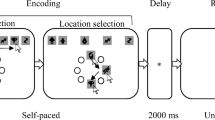Abstract
This paper proposes a novel experimental approach that would help to determine whether perspectival shapes, such as the elliptical profile of a tilted plate or coin, are part of perceptual experience. If they are part of perceptual experience, then it should be possible to identify these shapes simply by attending appropriately to them. Otherwise, in order to identify perspectival shapes they must first be constructed in the visual imagination. We propose that these accounts of perspectival identification can be tested by measuring the interference between visual and verbal working memory load, respectively, and the identification of perspectival shapes in the appearance of a 3D object.










Similar content being viewed by others
Notes
We use “perspectival shape” instead of “apparent shape” since there is a natural sense in which the objective shape is also apparent: e.g. the white face of the cube in Fig. 1 clearly looks square, and the billiards rack looks like an equilateral triangle, etc.
The properties of distance and slant (in 3D) are viewer-relative but do not count as perspectival properties for our purposes. That is because we consider them instead to be part of our experience of the 3D world around us. For example, the rim of a cup, when viewed obliquely, looks circular, slanted in depth, and located some distance away. What we call “perspectival properties” are (roughly) those that a painter would draw on a 2D canvas, i.e., those that 3D objects project onto a flat medium perpendicular to the line of sight. These do not include 3D slant and distance.
Notice that we are not committed to saying that your perspectival identification judgment is accurate. Indeed, Thouless (1931a, b) has famously shown that perspectival identification reports are distorted in the direction of the objective shapes. For example, while people can judge that the left perspectival angle of the billiard rack in Fig. 1 is smaller than 60 degrees, they probably overestimate its size (it is actually 45 degrees). For our purposes, it is enough that people can identify the perspectival shape of an object at least roughly.
Thus Cohen (2010) says (in our terminology) that the fact of our capacity for perspectival identification “gives us reason” to believe that visual perception represents perspectival properties. However, he does not claim that this is the only way to explain perspectival identification.
To clarify: We are not putting this account forward in the spirit of interpreting Gibson’s actual views. These were quite complicated, and settling what they were falls outside the scope of this paper.
Noë (2004) holds both that sensory experiences are ‘perspectival’, and that such ‘perspectival sensing’ plays a role, i.e. has a function, in everyday perceiving. As Noë notes, this is in keeping with long tradition in philosophy and in psychology. Our definition of the attentional and constructive accounts is supposed to be neutral on this issue. Seeing or visualizing perspectival shapes may or may not play a role in everyday perceiving. If the reader doubts that imagined perspectival shapes could play a role in everyday perception, we invite her to consider the phenomenon of amodal perception. Arguably, it involves mental imagery (Nanay 2010) and, nevertheless, it plays a role in everyday perception. For example, an amodally completed object can be the focus of object-based attention (Lee and Vecera 2005).
For another constructivist account of perspectival identification, see Schroer (2017). Unfortunately this paper came to our attention too late for us to engage with it in our essay.
Or, perhaps, “filling in” the maze from the origin point until an exit is reached.
To be clear, nothing in our argument will rest on this assumption. Indeed, the experimental methods we explore below could give a way of testing it.
To clarify, this question concerns not “first-order” certainty that the perspectival shape of the plate in the world is elliptical (though perhaps we should not have such certainty, because perspectival identification is somewhat inaccurate, as discussed in fn. 4 above). The question concerns Noë’s “second-order” certainty that the perspectival shape is seen (even if inaccurately) rather than imagined.
Before moving on, let us briefly explain why work on distortions in perspectival identification from the first half of the twentieth century (starting with Thouless 1931a, b) seems to us to be neutral with respect to the attentional/constructive dispute. This body of work has apparently shown that perspectival identification is distorted by cues for depth or shape constancy. That could be because subjects are make-perceiving the visual field on the basis of a visual experience that represents three-dimensional, “objective” features exclusively. Or it could be because the computational processes that generate the perspectival dimension of experiences are influenced in some way by 3D information (a view like this is endorsed by Hill 2009). So the findings in question are consistent with both the attentional and the constructive views.
Note that while falling short of establishing perspectivalism, finding the priming effect in question would establish something interesting, namely that visual representations of perspectival shapes activate shape concepts. Once activated, such concepts can facilitate and bias judgments related to them. On such a view, representations of perspectival shapes do more than just feed into modules that calculate objective shapes; they can influence cognitive processing in a more global way.
Note that there is a much larger body of literature about the effects of task-relevance on the phenomenon of “priming of pop-out,” in which a prime leads to faster location of a unique target resembling it, in a visual search task (for a review see the introduction in Michal et al., 2014).
Section 4.3 will address some difficulties with using 2D images for this purpose.
The task and stimuli illustrated assumes that retaining color information pertinently engages the resources underlying retention of imagined outline shape. We follow Hyun and Luck (2007) here. In their task (see Fig. 4), participants retain color information, which interferes with retention of the imagined (rotated) letter.
Alva Noë makes a related point in his (2008), at pp. 694–695.
There was a small interference in the opposite direction, but Hyun and Luck attributed it to a general dual-task cost (see discussion at the end of section 4.2).
The task in question involves names and distractor faces, which are special. But there are other studies from Lavie’s lab that use ordinary stimuli (e.g., letters) and equally support the conclusion that WM load interferes with selective attention (see Lavie 2005 for a review).
A clarification may be necessary here. In Baddeley and Hitch’s framework, what determines whether a given stimulus is stored in verbal or visual working memory is not the modality in which the stimulus is displayed, but rather the aspect of its content that is retained for later processing. For example, in the study by Sims and Hegarty (1997) the letter strings that had to be remembered in the verbal secondary tasks were presented as part of the visual display, as in Fig. 9b. Nevertheless, since participants were instructed to remember the letters themselves rather than the form or color of the stimulus, they read the letters silently and thus “converted” the information into a phonological form that was then carried by the articulatory loop.
In making this suggestion, Konstantinou et al. (2014) rely on a central thesis from Lavie’s perceptual load theory (see Lavie 2005), namely that attentional resources are allocated to task-relevant stimuli, and only if there are leftover resources are they allocated to task-irrelevant stimuli. In the dual task situation in question, there are two tasks that require resources of visual attention, and consequently there are no leftover attentional resources that could be allocated to task-irrelevant stimuli.
A study by Park et al. (2007) is an exception. The study found that visual memory load can impair selective attention, but it can do so only when the remembered item (face) matches the target category (face) and not the distractor category (house) in the selective attention task. We can safely avoid this complication as long as we make sure that in our proposed experiments, it is not the case that the visual item to be remembered matches the category of the target, but not of the distractor, in the selective attention task.
References
Baddeley, A. D., & Hitch, G. (1974). Working memory. Psychology of learning and motivation, 8, 47–89.
Bar, M., & Biederman, I. (1998). Subliminal visual priming. Psychological Science, 9(6), 464–468.
Briscoe, R. E. (2008). Vision, Action, and Make-Perceive. Mind & Language, 23(4), 457–497.
Brogaard, B. (2010). Strong Representationalism and Centered Contents. Philosophical Studies, 151, 373–392.
Cohen, J. (2010). Perception and Computation. Philosophical Issues, 20, 96–124.
de Fockert, J. W., Rees, G., Frith, C. D., & Lavie, N. (2001). The role of working memory in visual selective attention. Science, 291(5509), 1803–1806.
Eitam, B., & Higgins, E. T. (2010). Motivation in mental accessibility: Relevance of a representation (ROAR) as a new framework. Social and personality psychology compass, 4(10), 951–967.
Enns, J. T., & Oriet, C. (2007). Visual similarity in masking and priming: The critical role of task relevance. Advances in Cognitive Psychology, 3(1–2), 211.
Fish, W. (2009). Perception, Hallucination, and Illusion. Oxford: Oxford University Press.
Gao, Q., Chen, Z., & Russell, P. (2007). Working Memory Load and the Stroop Interference Effect. New Zealand Journal of Psychology, 36(3), 146.
Gibson, J. J. (1950). The Perception Of The Visual World. Boston: Houghton Mifflin.
Gibson, J. J. (1986). The Ecological Approach to Visual Perception. Hillsdale: Lawrence Erlbaum Associates.
Grush, R. (2004). The emulation theory of representation: Motor control, imagery, and perception. Behavioral and Brain Sciences, 27, 377–442.
Harman, G. (1990). The Intrinsic Quality of Experience. Philosophical Perspectives, 4, 31–52.
Hellie, B. (2006). Beyond Phenomenal Naiveté. Philosophers’ Imprint, 6(2). Retrieved from www.philosophersimprint.org/006002/.
Henik, A., & Tzelgov, J. (1982). Is three greater than five: The relation between physical and semantic size in comparison tasks. Memory & cognition, 10(4), 389–395.
Hibbard, P. B., Haines, A. E., & Hornsey, R. L. (2017). Magnitude, precision, and realism of depth perception in stereoscopic vision. Cognitive Research: Principles and Implications, 2(1), 25.
Hill, C. (2009). Consciousness. Cambridge, England: Cambridge University Press.
Hopp, W. (2013). No such look: Problems with the dual content theory. Phenomenology and the Cognitive Sciences, 12(4), 813–833.
Hyun, J. S., & Luck, S. J. (2007). Visual working memory as the substrate for mental rotation. Psychonomic bulletin & review, 14(1), 154–158.
Kelly, S. D. (2008). Content and constancy: Phenomenology, psychology, and the content of perception. Philosophy and Phenomenological Research, 76(3), 682–690.
Konstantinou, N., Beal, E., King, J. R., & Lavie, N. (2014). Working memory load and distraction: dissociable effects of visual maintenance and cognitive control. Attention, Perception, & Psychophysics, 76(7), 1985–1997.
Lavie, N. (2005). Distracted and confused?: Selective attention under load. Trends in cognitive sciences, 9(2), 75–82.
Lee, H., & Vecera, S. P. (2005). Visual cognition influences early vision: the role of visual short-term memory in amodal completion. Psychological Science, 16(10), 763–768.
Lycan, W. G. (1996). Consciousness and Experience. Cambridge: The MIT Press.
Mack, A. (1978). Three modes of visual perception. In M. H. Pick (Ed.), Modes of perceiving and information processing (pp. 171–186). Hillsdale: Erlbaum.
Michal, A. L., Lleras, A., & Beck, D. M. (2014). Relative contributions of task-relevant and task-irrelevant dimensions in priming of pop-out. Journal of vision, 14(12), 14–14.
Nanay, B. (2010). Perception and imagination: amodal perception as mental imagery. Philosophical Studies, 150(2), 239–254.
Noë, A. (2004). Action in Perception. Cambridge.: MIT Press.
Noë, A. (2008). Reply to Campbell, Martin, and Kelly. Philosophy and Phenomenological Research, 76(3), 691–706.
Palmer, S. E. (1999). Vision Science: Photons to Phenomenology. Cambridge, Mass.: MIT Press.
Park, S., Kim, M. S., & Chun, M. M. (2007). Concurrent working memory load can facilitate selective attention: evidence for specialized load. Journal of Experimental Psychology: Human Perception and Performance, 33(5), 1062.
Pohl, C., Kiesel, A., Kunde, W., & Hoffmann, J. (2010). Early and late selection in unconscious information processing. Journal of Experimental Psychology: Human Perception and Performance, 36(2), 268.
Robbins, T. W., Anderson, E. J., Barker, D. R., Bradley, A. C., Fearnyhough, C., Henson, R., Hudson, S. R., & Baddeley, A. D. (1996). Working memory in chess. Memory & Cognition, 24(1), 83–93.
Rock, I. (1983). The Logic of Perception. Cambridge: The MIT Press.
Schellenberg, S. (2008). The Situation-Dependency of Perception. The Journal of Philosophy, 105(2), 55–84.
Schroer, R. (2008). The woman in the painting and the image in the penny: an investigation of phenomenological doubleness, seeing-in, and ‘reversed seeing-in’. Philosophical Studies, 139(3), 329–341.
Schroer, R. (2017). Hume's Table, Peacocke's Trees, the Tilted Penny and the Reversed Seeing-in Account. Mind & Language, 32(2), 209–230.
Schwitzgebel, E. (2011). Perplexities of consciousness. MIT Press.
Siewert, C. (2006). Is the appearance of shape protean? Psyche, 12(3), 1–16.
Sims, V. K., & Hegarty, M. (1997). Mental animation in the visuospatial sketchpad: Evidence from dual-task studies. Memory & Cognition, 25(3), 321–332.
Smith, A.D. (2002). The Problem of Perception. Harvard University Press.
Thouless, R. H. (1931a). Phenomenal regression to the real object. Part I. The British Journal of Psychology, 21, 339–359.
Thouless, R. H. (1931b). Phenomenal regression to the real object. Part II. The British Journal of Psychology, 22, 1–30.
Tye, M. (2002). Consciousness, Color, and Content. Cambridge: The MIT Press.
Vishwanath, D. (2014). Toward a new theory of stereopsis. Psychological Review, 121(2), 151–178.
Watt, S. J., Akeley, K., Ernst, M. O., & Banks, M. S. (2005). Focus cues affect perceived depth. Journal of vision, 5(10), 834–862.
Yi, D. J., Woodman, G. F., Widders, D., Marois, R., & Chun, M. M. (2004). Neural fate of ignored stimuli: dissociable effects of perceptual and working memory load. Nature neuroscience, 7(9), 992.
Weksler, A. (2016). Retinal images and object files: towards empirically evaluating philosophical accounts of visual perspective. Review of Philosophy and Psychology, 7(1), 91–103.
Weksler, A. (2017). Attention to mental paint and change detection. Philosophical Studies, 174(8), 1991–2007.
Acknowledgements
We wish to thank Galia Avidan, Robert Briscoe, Zohar Bronfman, Randy Clarke, Paul Conway, Baruch Eitam, Jonathan Folstein, Nurit Gronau, Sean Kelly, Arnon Keren, Ariel Meirav, Lior Shmuelof, Mark Wagner, Aaron Wilbur, Wayne Wu, Yaffa Yeshurun, and two anonymous referees for helpful feedback and discussion.
Author information
Authors and Affiliations
Corresponding author
Additional information
Both authors contributed equally to this work.
Rights and permissions
About this article
Cite this article
Schwenkler, J., Weksler, A. Are perspectival shapes seen or imagined? An experimental approach. Phenom Cogn Sci 18, 855–877 (2019). https://doi.org/10.1007/s11097-018-9571-1
Published:
Issue Date:
DOI: https://doi.org/10.1007/s11097-018-9571-1




